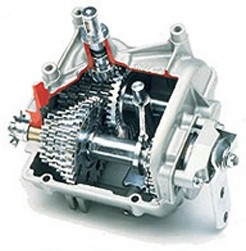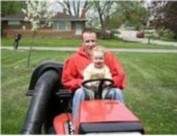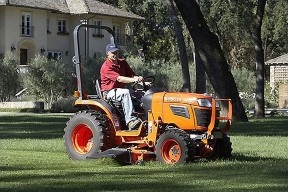Tractor Safety: Lawn Care Training Guide, Safe Use of Tractors
ID
BSE-48P (BSE-321P)
Tractors are versatile equipment used in a variety of jobs ranging from hauling goods to lawn care to agriculture. While they are extremely versatile, they can be very dangerous unless they are used with care following safe practices. Accidents resulting in fatalities and severe injuries are very common during tractor use. The National Safety Council estimated that approximately 36 percent of all the agricultural fatalities in 1997 involved a tractor. Published data also show that farm accidents cause more than 100 deaths and about 2,600 serious injuries among children annually. Tractors account for about 41 percent of the accidental deaths among children under 15 years of age. In spite of these convincing data, a large number of operators continue to follow unsafe practices that can cause serious accidents.
Tractors used in the green industry are generally smaller than those used in other kinds of agriculture. They are also unsafe because they are unstable and they overturn easily.
The purpose of this training guide is to familiarize supervisors and managers in the green industry with compact tractors and how they can be used safely. Subject matters covered in this publication include major components of these tractors, built-in safety features on the tractor, and safe practices during tractor use. The hope is that supervisors will use this information to train young workers they hire and supervise on the safe use of tractors.
Tractors Used in Green Industry
Tractors are widely used in the green industry for different jobs. The most common use is mowing grass. Other uses include towing, tilling, raking, sweeping, seeding, spreading fertilizer, spraying, aerating soil, thatching, and shredding. Tractors of many different sizes are used in the green industry. The size generally depends on the type of application. They may be grouped into three categories: riding lawn mowers, lawn and garden tractors, and large tractors.


1. Riding Lawn Mowers
Generally, riding mowers come with power units in the 8 to 25 horsepower range and a mower. They do not come with other attachments that could be mounted separately to carry out other jobs.
2. Lawn and Garden Tractors
Lawn and garden tractors are often referred to as compact tractors. They range in size from 12 to 32 horsepower, and they come with a variety of attachments for different jobs. Some examples of these attachments may include sweepers, seeders, blades, and tillers.

3. Large Tractors
Power rating of large tractors can range from 18 to 80 horsepower. Most tractors in this category are light industrial tractors of 20 to 45 horsepower. They are widely used on golf courses, parks, schools, and college campuses, and they generally have a low center of gravity for added stability when working on slopes. Tractors with up to 80-horsepower capacity and farm tractors are used infrequently in the green industry for heavier jobs. In this publication, tractors with 18 horsepower and greater are referred as large tractors.
Power Unit
For proper tractor use and for safety purposes, the operator must be familiar with the kind of power unit on the equipment. Operating procedures vary significantly depending on the type of power unit. Three types of power units are used on tractors used in the green industry: (1) air-cooled engines, (2) liquid-cooled engines, and (3) electric motors.
1. Air-Cooled Engines
The power units used in lawn care applications are usually air-cooled. Because no liquid is used in cooling the engines, they have no radiators. They may be either two- or four-cycle engines. Most tractors used in lawn care applications are equipped with four-cycle engines. One may identify whether the engine is two-cycle or four-cycle based on the location of the exhaust or muffler, the presence of an oil sump, or information on the name plate.
2. Liquid-Cooled Engines
Lawn and garden tractors and large tractors have larger-capacity engines. They are either gasoline or diesel engines with a radiator and a fan. Depending on the size, these engines may have two to six cylinders and they run on gasoline, diesel, or liquified petroleum gas. Gasoline engines are more common than the other two. All the engines may look similar, but they can be differentiated by observing the presence of fuel injectors for diesel engines and a gas tank for liquid petroleum gas engines.
3. Electric Motors
Storage batteries are also used to power tractors. Electric tractors are generally small and range from 5 to 14 horsepower. The number of batteries on the tractor may depend on its size. Between uses, the batteries are recharged using a built-in charger connected to a standard 120-volt power source.
Transmission System
Tractors are used as work horses on farms and in lawn care operations. The power generated by the tractor’s engines needs to be transmitted to appropriate locations for doing useful work. The transmission system or power train on tractors transmits power generated by the engine to the wheels or elsewhere. To use tractors effectively, the operator must be familiar with the type of transmission in them. Tractor transmissions operate differently from automobile transmissions. Some transmissions require that a tractor be stopped before changing gears. Others, on the other hand, have gears that can be shifted on the go without using a clutch. For this reason, tractor operators are advised to review the operator’s manual and become familiar with the type of transmission and operation. The most common types of transmissions on tractors are manual-shift transmissions, power-shift transmissions, and hydrostatic transmissions.
Manual-Shift Transmission
With a manual-shift transmission, the operator engages or disengages the gear to get to the desired speed or to select forward or reverse directions. The manual-shift transmission may be either a sliding- or planetary-gear type. For shifting a sliding gear, one has to disengage the clutch first, shift the gear with shift lever, and then reengage the clutch. Most tractors with a sliding-gear transmission have three or more forward gears and one reverse gear. Sliding-gear transmission with synchromesh will allow shifting of the gears on the go.

Planetary-gear transmissions are more common on large tractors and may be shifted while moving. Manual-shift tractors use a clutch to disengage the engine from transmission when shifting gears. When the clutch is engaged, power is transmitted from the engine shaft through the clutch to the transmission. When the clutch is disengaged, the clutch plates are separated and the engine is disengaged from transmission.
Most tractors with manual transmission used in lawn care operations use one of the following four ways to transmit the power from the engine to the wheels of the tractor: (1) transaxle with belts, (2) differential with separate transmission and chain and sprocket, (3) disk drive with belt or chain, (4) all-gear drive.
The transaxle type is the most common on riding mowers and garden tractors with manual transmissions. Operators should refer to the operator’s manual for the mowers or garden tractors they use in order to become familiar with the type of transmission system and its maintenance requirements.
Hydrostatic Transmissions
Many tractors used in lawn care applications are equipped with hydrostatic transmissions for versatility and ease of operation. Hydrostatic transmissions make it possible to change the direction of the tractor quickly without a clutch. They also provide infinite speed control from 0 to about 7 mph in forward and from 0 to about 4 mph in reverse. Often the hydrostatic transmission can be coupled to a differential.

The major components of a hydrostatic transmission can include a variable displacement pump, reservoir, control valves, and a hydraulic motor. Tractors with hydrostatic transmissions may be equipped with either a hand or foot control for adjusting the speed. Hand levers are more common because of ease in controlling speed and direction.
Power Transmission Options
When tractors are used in lawn care operations, tractor power must be transmitted to the respective devices used to carry out the work. Power may be transmitted to the devices using one of five ways: belt, chain, power takeoff, drawbar, and hydraulic. The belt drive is most common on riding mowers and garden tractors. Chain drives are used for heavy applications such as snow removal.
Transferring power through power takeoff is widely used on small and large tractors. Operators have to be extremely careful when using PTO to utilize tractor power for useful work because the PTO is known to cause numerous accidents. Precautionary steps that can be taken to avoid such accidents may include the following:
Make sure the PTO shield is in place and mounted properly.
Follow the recommended shutdown procedure and dismount the tractor only when the rotating parts came to a standstill.
Never step over a rotating shaft.
Avoid loose clothing, loose shoelaces, and loose hair when operating PTO.

For certain applications, power is not directly transmitted to the device. Instead, tractor wheels interacting with ground transmit power to the drawbar to utilize for useful work. Hydraulic systems are also widely used for operating mowers.
Safety Features and Guards
Tractors of all sizes, ranging from lawn and garden tractors to regular farm tractors, are equipped with many safety features to protect the operator. An example of such a device is automatic cutoff for the mower blade when the tractor is not moving or when the operator leaves the tractor seat. Operators must be familiar with all the safety features available on the equipment. Because these features differ, the operator should depend on the operator’s manual for specifics. Under no circumstances should these safety features be tampered with or disconnected. On the contrary, operators must periodically check and make sure they are functioning properly.

As stated earlier, tractors can be dangerous if they are not operated with care. Sideways, rearward and frontward overturning of tractors are common. Among these, sideways overturning is the most common, accounting for about 75 to 80 percent of tractor upsets. The other two types are more dangerous; each year, these result in a large number of fatalities and serious injuries. In recent years, the required use of rollover protection structures has significantly reduced the number of fatalities and injuries. While ROPS are not capable of avoiding tractor upsets, they are very effective in protecting the operators if and when an upset occurs. When using a tractor with ROPS, operators must always wear the seat belt to avoid being thrown out during a tractor upset.
A large number of old tractors, sold prior to when the ROPS requirement went in effect, is still in use without ROPS. For the well-being of operators, it is highly recommended that these tractors be retrofitted with ROPS that meet the established standard.
Tractors and other equipment also come with guards to protect operators from rotating parts. Under no circumstances should these safety guards be removed. Operators must check to make sure that they are in place properly.
Operater’s Manual
The operator’s manual that comes with any equipment is an important document because it contains valuable information on safety features, servicing information, the maintenance schedule, and tips for safe operation. Prior to operating tractors, all operators must be familiar with the content of the manual for quick reference when needed and to operate the tractor effectively and safely.
General Tractor Safety Tips
Read and understand the operator’s manual before using the equipment. Become familiar with the safety features, items to check before operating the tractor, starting and stopping the tractor, and the maintenance schedule.
Check the crank case, air cleaner, battery, cooling system, fuel tank, transmission system, hydraulic system, and tires before operating the tractor. Refer to the operator’s manual for checking and servicing details.
Make sure the safety features are working properly and the guards and shields are in place.
Do not drive riding mowers and garden tractors on public roadways. When taking larger tractors on the road, use flashing lights and slow moving vehicle emblems.
Make sure tractors are equipped with rollover protection structures and always use seatbelts, particularly when the tractors are equipped with ROPS.
Do not under any circumstances take an extra rider in the tractor.

Never leave the tractor running unattended.
Never turn the tractor engine on inside an enclosed area. If it must be done, make sure that the building is properly ventilated.
- Refuel the tractor when the engine is cold. Also make sure the fuel is stored properly.
Tips for Safe Operation of Tractors
Survey the area to be mowed and remove all debris, such as rocks, cans, wire, toys, etc., before mowing to avoid personal injuries and other damages.
Be alert and watch for moving vehicles, people, or animals in the work area while operating a tractor. Be prepared to change course or stop quickly.
Avoid mowing too close to trees to prevent damage to trees and personal injuries from low-lying branches.

Maintain proper speed during operation. A hole, bump, or a quick turn at high speed can cause tractor upset. Use the widest possible wheel spacing and proper ballasting to improve stability.
Move up and down at slow speed when operating on a slope. Use the same gear setting for going up or down the hill and allow the engine to act as a brake. On steep slopes, it is a good practice to go up in reverse to reduce the chance for backward overturning.

Stop mower blades before crossing gravel patches.
Do not dismount from the operator’s seat while an attachment on the tractor is running.
Make sure the path is clear when backing up a tractor. Some lawn and garden tractors have a forward/ reverse lever that will reverse the tractor with a short pause.
Stay clear of ditches, embankments, and ponds. Transfer power slowly to the wheels when driving out of a ditch to avoid a tractor upset.
Never leave a tractor unattended with the engine running.
Use appropriate personal protective equipment (safety shoes, ear protection, respirator, safety glasses, proper clothing, etc.) when operating a tractor.
Always hitch implements to the drawbar or the three-point hitch. Never hitch a chain to the axle or other high point on the tractor.
Every attachment is a potentially dangerous tool to be handled with special care. Refer to the appropriate attachment’s operator’s manual for operating and safety instructions. For stability, some attachments require counterweights at the opposite end of the tractor.
Resources
Tractor Safety. Colorado State University. Fact Sheet No. 5.016.
Child Tractor Safety. National Children’s Center for Rural and Agricultural Health, Marshfield Clinic Research Foundation. Marshfield, WI.
Worker Health Chartbook. DHHS (NIOSH) Publication No. 2004-146. Cincinnati, OH: NIOSH.
Tractor Safety for the Landscaping and Horticultural Services Industry. Kansas State University Agricultural Experiment Station and Cooperative Extension Service. Publication MF-2708. KS: K-State Research and Extension.
Safety Management for Landscapers, Grounds-Care Businesses and Golf Courses: Perfect Training Tool Using the Safest Way to Operate Outdoor Power Equipment: Loaded With Illustrations and True-to-Life Stories. Moline, IL: Deere & Co.
Safe Operation of Compact Tractors. Virginia Cooperative Extension. Publication 442-093. http://pubs.ext.vt.edu/442/442-093/442-093_pdf.pdf.
Safer Tractor Operations for Landscape Maintenance and Horticultural Industries. Florida Cooperative Extension Service. Publication CIR1252.
Mowing and Trimming Safety for the Landscaping and Horticultural Services Industry. Kansas State University Agricultural Experiment Station and Cooperative Extension Service. Publication MF-2714 rev. Manhattan, KS: K-State Research and Extension.
National Safety Council Website. www.nsc.org/.
Tailgate Safety Training for Landscaping and Horticultural Services. Fact Sheets: AEX.192.1.40 (PTO shielding), AEX.192.1.56 (ROPS), AEX.192.1.64 (PTO), AEX.192.1.65 (tractors), AEX.192.1.66 (tractor starting and stopping), AEX.192.1.80 (loader), AEX.192.1.81 (towed equipment), AEX.192.2.32 (no riders), AEX.192.2.80 (loader; for trainers).
The Ten Commandments of Tractor Safety. Farm Machinery Fact Sheet FM-27.
Acknowledgements
This publication was developed with the support of the National Youth Farm Safety Education and Certification Program (Grant No. USDA/NIFA-2010-41521-20830), the National Institute of Food and Agriculture, and the U.S. Department of Agriculture. The team that developed this publication is solely responsible for its content, and it does not necessarily reflect the views of the USDA or the U.S. Department of Labor. The team members are: Robert Grisso, John Perumpral, Don Ohanehi, Mike Goatley, Kathleen Jamison, Cathy Sutphin, Dan Swafford, and Carl Estes.
The authors are grateful to the following for permission to use their pictures and figures: Kansas State University, Kubota Tractor Corp., The Toro Company, and DR Power Equipment.
Virginia Cooperative Extension materials are available for public use, reprint, or citation without further permission, provided the use includes credit to the author and to Virginia Cooperative Extension, Virginia Tech, and Virginia State University.
Virginia Cooperative Extension is a partnership of Virginia Tech, Virginia State University, the U.S. Department of Agriculture, and local governments. Its programs and employment are open to all, regardless of age, color, disability, sex (including pregnancy), gender, gender identity, gender expression, national origin, political affiliation, race, religion, sexual orientation, genetic information, military status, or any other basis protected by law
Publication Date
January 29, 2024



